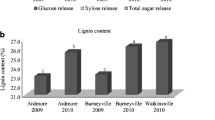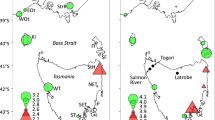Summary
A random sample of 80 families of the B8HD smooth bromegrass (Bromus inermis Leyss.) population were tested in three environments for forage yield and cell wall constituents. Expected progress from one cycle of family selection was computed for single-trait selection and multiple-trait restricted selection. Expected gains were compared to desired goals and actual results from one cycle of phenotypic selection. Desired goals were: Model I = reduced lignin and cellulose, with increased hemicellulose, resulting in no change in cell wall content; Model II = reduced lignin and cellulose with no change in hemicellulose; or Model III = reduced lignin, cellulose, and hemicellulose. Single-trait selection for high hemicellulose in first harvest or low cellulose in second harvest had the best expected responses, of any single trait, for Model I. Possible undesirable effects of selection for low cellulose would be a reduction in forage yield potential. Multiple-trait restricted selection was judged to be more effective, with responses all in the desired direction, by specifying increased hemicellulose in index development. Selection in second harvest was expected to have similar responses as first harvest, except for a greater increase in forage yield. Development of Models II or III is expected to be difficult due to a negative correlation estimate between first and second harvest cell wall concentration.
Similar content being viewed by others
References
Anderson B, Ward JK, Vogel KP, Gorz HJ, Haskins FA (1988) Forage quality and performance of yearlings grazing switchgrass strains selected for differing digestibility. J Anim Sci 66:2239–2244
Baker RJ (1986) Selection indices in plant breeding. CRC Press, Boca Raton
Burton GW, Hart RH, Lowrey RS (1967) Improving forage quality in bermudagrass by breeding. Crop Sci 7:329–332
Carpenter JA (1988) Divergent phenotypic selection for forage yield and nutritive value traits in smooth bromegrass. PhD thesis, University of Wisconsin-Madison (Diss Abstr ADG88-09020)
Casler MD (1986) Causal effects among forage yield and quality measures of smooth bromegrass. Can J Plant Sci 66:591–600
Casler MD (1987) In vitro digestibility of dry matter and cell wall constituents of smooth bromegrass forage. Crop Sci 27:931–934
Casler MD, Carpenter JA (1989) Morphological and chemical responses to selection for in vitro digestibility in smooth bromegrass. Crop Sci 29:924–928
Casler MD, Ehlke NJ (1986) Forage yield and yield component changes with divergent selection for in vitro dry matter digestibility of smooth bromegrass. Crop Sci 26:478–481
Casler MD, Hovin AW (1985) Predicting forage yield from morphological traits in reed canarygrass. Crop Sci 25:783–787
Christie BR (1977) Effectiveness of one cycle of phenotypic selection on in vitro digestibility in bromegrass and orchardgrass. Can J Plant Sci 57:57–60
Coors JG, Lowe CC, Murphy RP (1986) Selection for improved nutritional quality of alfalfa forage. Crop Sci 26:843–848
Ehlke NJ, Casler MD, Drolsom PN, Shenk JS (1986) Divergent selection for in vitro dry matter digestibility in smooth bromegrass. Crop Sci 26:1123–1126
Eichhorn MM Jr, Oliver WM, Hallmark WB, Young WA, Davis AV, Nelson BC (1986) Registration of ‘Grazer’ bermudagrass. Crop Sci 26:835
Godshalk EB, Timothy DH, Burns JC (1988) Application of multistage selection indices to crop improvement. Crop Sci 28:23–26
Goering HK, Van Soest PJ (1970) Forage fiber analysis (apparatus, reagents, procedures, and some applications). USDA-ARS Agric Handb 379, US Govt Print Off, Washington, DC
Hallauer AR, Miranda Fo, JB (1981) Quantitative genetics in maize breeding. Iowa State University Press, Ames
Harville DA (1975) Index selection with proportionality constants. Biometrics 31:223–225
Knowles RP (1969) Nonrandom pollination in polycrosses of smooth bromegrass, Bromus inermis Leyss. Crop Sci 9:58–61
Knowles RP (1980) Seedling pubescence as a genetic marker in smooth bromegrass (Bromus inermis Leyss.). Can J Plant Sci 60:1173–1180
Morrison IM (1980) Hemicellulosic contamination of acid detergent residues and their replacement by cellulose residues in cell wall analysis. J Sci Food Agric 31:639–645
Norris KH (1985) Definition of NIRS analysis. In: Marten GC, Shenk JS, Barton FE II (eds) Near infrared reflectance spectroscopy (NIRS): analysis of forage quality. USDA-ARS Agric Handb 643, US Govt Print Off, Washington/DC, p 6
Petersen HL (1976) Competition in Lolium perenne L. as measured by yield and persistency. In: Dennis B (ed) Breeding methods and variety testing in forage plants. Proc EUCARPIA Fodder Crops Sec, 7–9 September. Royal Veterinary and Agricultural University Højbakkegård, pp 129–140
Reich JM, Casler MD (1985) Effect of maturity and alfalfa competition on expected selection response for smooth bromegrass forage quality traits. Crop Sci 25:635–640
Robertson JB, Van Soest PJ (1981) The detergent system of analysis and its application to human foods. In: James WPT, Theander O (eds) The analysis of dietary fiber in food. Marcel Dekker, New York, pp 123–158
Rogers HH, Lazenby A (1966) Selection criteria in the breeding of grasses. In: Hill AGG (ed) Proc 10th Intl Grassl Congr, 7–16 July, Helsinki. Finnish Grassland Assn, Salomonkatu, pp 630–633
Ross JG, Bullis SS, Lin KC (1970) Inheritance of in viro digestibility in smooth bromegrass. Crop Sci 10:710–712
Rotili P, Zannone L, Gnocchi G (1976) Effects of association and density in clones of tall fescue (Festuca arundinacea L.). In: Dennis B (ed) Breeding methods and variety testing in forage plants. Proc ECARRPIA Fodder Crops Sec, 7–9 September. Royal Veterinary and Agricultural University, Høajbakkegård, pp 141–151
Searle SR (1982) Matrix algebra useful for statistics. Wiley, New York
Sleper DA, Drolsom PN, Jorgensen NA (1973) Breeding for improved dry matter digestibility in smooth bromegrass (Bromus inermis Leyss.). Crop Sci 13:556–559
Tai GC (1977) Index selection with desired gains. Crop Sci 17:182–183
Author information
Authors and Affiliations
Additional information
Communicated by A.R. Hallauer
Rights and permissions
About this article
Cite this article
Casler, M.D., Carpenter, J.A. & Attewell, J.R. Selection strategies for developing smooth bromegrass cell wall ideotypes. Theoret. Appl. Genetics 78, 775–782 (1989). https://doi.org/10.1007/BF00266657
Received:
Accepted:
Issue Date:
DOI: https://doi.org/10.1007/BF00266657




